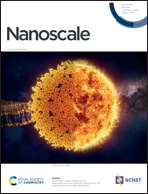The dual nature of biomimetic melanin†
Abstract
Melanin-inspired nanomaterials offer unique photophysical, electronic and radical scavenging properties that are widely explored for health and environmental preservation, or energy conversion and storage. The incorporation of functional melanin building blocks in more complex nanostructures or surfaces is typically achieved via a bottom-up approach starting from a molecular precursor, in most cases dopamine. Here we demonstrate that indeed, the oxidative polymerization of dopamine, for the synthesis of melanin-like polydopamine (PDA), leads to the simultaneous formation of more than one nanosized species with different compositions, morphologies and properties. In particular, a low-density polymeric structure and dense nanoparticles (NP) are simultaneously formed. The two populations could be separated and analyzed in real time using a chromatographic technique free of any stationary phase (flow field fractionation, FFF). The results following the synthesis of melanin-like PDA showed that the NP are formed only during the first 6 hours as a result of a supramolecular self-assembly-driven polymerization, while the formation of the polymer continues for about 36 hours. The two populations were also separated and characterized using TEM, UV–vis absorption spectroscopy, fluorescence and light scattering spectroscopy, DLS, FTIR, ζ-potential measurements, gel electrophoresis and pH titrations. Interestingly, very different properties between the two populations were observed: in particular the polymer contains a higher number of catechol units (8 mmol g−1 –OH) with respect to the NP (1 mmol g−1 –OH) and presents a much higher antioxidant activity. The attenuation of light by NP is more efficient than that by the polymer especially in the Vis-NIR region. Moreover, while the NP scatter light with an efficiency up to 27% they are not fluorescent, and the polymer does not scatter light but shows an excitation wavelength-dependent fluorescence typical of multi-fluorophoric uncoupled systems.



 Please wait while we load your content...
Please wait while we load your content...